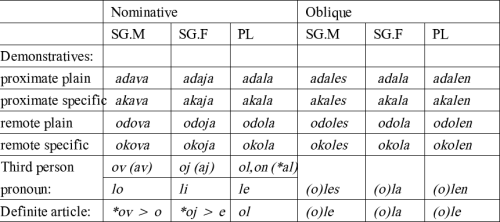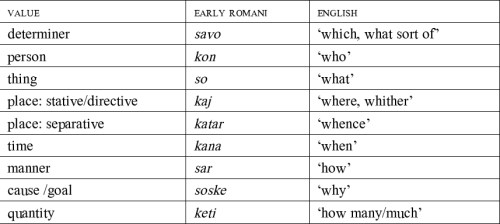The structure of Romani
Nominals
ER nouns had two genders, masculine and feminine, and two numbers, singular and plural. Modifiers generally agreed with their head nouns. Agreement was marked on adjectives, definite articles, demonstratives, and via a typical Indo-Aryan double-case phenomenon (see Plank 1995), also genitive attributes: čhav‑es‑ker‑o dad ‘the boy’s father’, čhav‑es‑ker‑i daj ‘the boy’s mother’. Gender agreement was neutralised in the plural. Case marking appears to have been sensitive to animacy to some extent.
Case marking and declension classes
The case marking system preserved the late Indo-Aryan system of three layers (cf. Masica 1991). The most archaic layer, Layer I, is closest to the noun stem, distinguishes nominative and oblique cases, and is sensitive to declension class (Figure 2) (cf. Elšík 2000b for a recosntruction of ER declension classes). Among the inherited or oikoclitic declension classes (traditionally referred to in Romani linguistics as ‘thematic’ (European)) we find distinct classes for the masculine and the feminine, further differentiated into several vocalic and consonantal (sub)classes and, within the feminine, also into jotated and unjotated (sub)classes; there was also a distinct declension (sub)class for abstract nominalisations. The inflections tend to derive from OIA/MIA nominal derivational markers in the nominative, and from remnants of the OIA/MIA genitive case in the oblique.
In addition to the inherited declension classes, ER develops several classes for borrowed nouns, or xenoclitic classes (traditionally referred to in Romani linguistics as ‘athematic’ (Non-European)). The formation of these declension classes is based on the incorporation of Greek nominative inflections, whereby the neuter gender is integrated into the masculine classes, resulting in variation in the presence of the (originally masculine) inflection ‑s in the relevant classes. In the oblique, the vowel of the oikoclitic singular masculine marker has been assimilated to the vowel of the Greek-derived nominative markers (e.g. *-es- > -os- in the xenoclitic o-masculines). The plural oblique of xenoclitic classes was not distinct from that of oikoclitic classes in ER. This Greek-based class differentiation became a stable component of the ER declension system. Occasional loans from languages other than Greek were assigned one of the Greek-derived inflections. As the Romani-speaking population groups broke away from Greek-speaking territory, the Greek-derived system continued to serve as a grid for the incorporation of more recent loans from the new contact languages. The system eventually underwent considerable levelling in the individual dialects, but continues in present-day dialects to mark out European loanwords.
Figure 2: Early Romani nominal declension classes

The nominative case was that of the subject as well as of the inanimate direct object. The oblique case had several uses, which included the marking of the animate direct object, and quite likely also the marking of the possessor, the external possessor (as in ‘I am cold’ or ‘I have a headache’; see Koptjevskaja-Tamm 2000, König & Haspelmath 1997), and the recipient of the verb ‘to give’. Apart from these functions, the oblique served as the basis for Layer II case markers. These derive from a set of enclitic markers which in ER (and probably earlier) are fused with the noun, forming an agglutinating set which shows consonant alternation determined by the final segment of the preceding preceding Layer I suffix (see Figure 3).
Figure 3: Early Romani Layer II case markers (sg/pl)
| dative | locative | ablative | sociative | genitive |
| -ke/-ge | -te/-de | -tar/-dar | -sa | -ker‑/-ger- |
Layer II suffixes mark a Dative, Locative, Ablative, Sociative (Instrumental-Comitative), and a Genitive which agrees with its head through Suffixaufnahme. The Locative in ‑te/-de appears to derive from the older dative, at the expense of an old locative in *-me, which may have existed earlier (as in other NIA languages, including Domari), while the new dative in ‑ke/‑ge is essentially a benefactive.
Adjectival modifiers
There are several distinct patterns of modifier inflection in ER (Figure 4):
Figure 4: Early Romani adjectival inflection

The distinction between oikoclitic and xenoclitic forms was found in (descriptive) adjectives as well. Oikoclitic forms were typical of inherited descriptive adjectives, but also of participles, of the interrogative indefinite sav‑o ‘which’, of the deictic determiner asav‑o ‘such’, and of the universal determiner savoř‑o ‘all, entire, the whole’. Cardinal numerals and the quantifier but ‘much, many’ lacked overt nominative inflections, but took oblique suffixes. Xenoclitic adjectival inflections derive in part from Greek (in the nominative), or show the intrusive suffix -on- plus oikoclitic inflections (in the oblique). They are assigned to Greek-derived adjectives (and, as with nouns, they later accompany adjectival loans from subsequent contact languages in the individual dialects), as well as to the ordinal numerals (which are formed through addition of Greek-derived ‑to) and the Slavic-derived quantifier vsako ‘every’. Marginally, there were indeclinable adjectives (šukar ‘beautiful, nice’), quantity interrogatives (keti ‘how much’), or quantity deictics (ati ‘as much as’).
Different patterns of agreement characterised two other modifer classes: demonstratives and definite articles. The nominative singular demonstrative inflections M ‑va and F ‑ja may have derived from an assimilation of earlier, regular adjectival inflections with a postposed deictic *‑a (cf. Matras 2002: 107-108), which together replaced the original consonantal deictic root. In the oblique singular, and in the plural forms, the original deictic root ‑l‑ is preserved. In the nominative plural, the root is followed by very same postposed deictic ‑a, while the oblique forms show inflections that match the oikoclitic inflection pattern of adjectives. The definite article is related to the demonstrative, and we find similar forms in the more conservative oblique inflections. In the nominative, the forms were shortened, giving a new pattern of inflection. The simplification of the nominative singular forms in particular may have been influenced by the corresponding Greek form (o, i).
Demonstratives and related forms
Here we consider the formation of demonstrative roots, and related expressions. The original deictic root ‑l‑ tends to be preserved in the oblique forms and in the nominative plural. The pronominal demonstrative took nominal inflections in the oblique, while in the nominative we find the adjectival-demonstrative inflections discussed above (see Figure 4). The outstanding feature of ER demonstratives is their renewed composition: new consonantal roots are preposed to the older demonstratives. These consonantal roots derive from the deictic expressions of location, adaj ‘here’, odoj ‘there’, akaj ‘precisely here’, okoj ‘precisely there’. The roots in -d‑ thus indicate general deictic reference, while those in ‑k‑ indicate specificity. The vocalic patterns – ‑a‑ versus ‑o‑ – indicate distance or source of reference (situation vs. discourse). The renewed paradigm constitutes a four-term system. This same system is continued in the more conservative dialects (in the Balkans, in some of the Italian dialects, and in Welsh Romani). In other dialects, some of the forms are simplified to kava, dava etc., while in others various forms of ‘strengthening’ occur (e.g. *aka-adava > kadava).
Figure 5: Early Romani deictic and anaphoric expressions

There are two competing forms of the third person pronoun, both deriving ultimately from demonstratives. The ancient demonstrative stem in ‑l‑ is continued, with normal nominal inflection (of the oikoclitic vowel classes), in a reduced pronoun, which presumably was reserved for highly continuous referents: lo, li, le. Later on, many of the dialects lost this form completely, or restricted its distribution to non-verbal predications. Alongside this older set, ER had a renewed set of emphatic subject pronouns: ov/av, oj/aj, ol/al. These derived from the demonstrative in its intermediate stage – following the loss, in the nominative singular, of the ancient stem in ‑l‑, but prior to the ‘strengthening’ which characterises the emergence of a new four-term system in ER – in a syncopated form, showing loss of the final vowel. It is from the remote forms of this paradigm – ov, oj, ol – that the definite article emerged, copying the pattern of a preposed definite article in the contact language, Greek.
Personal pronouns
Third person pronouns were dealts with above, and we limit ourselves in this section to deictic personal pronouns, and reflexives. ER inherited an archaic system of first and second person pronouns (see Figure 6). They show numerous irregularities, such as the marking of the plural by the suffix -m- in 1pl a-m- and 2pl tu-m-. The 1sg pronoun stands out in having distinct suffixes in the nominative and oblique, respectively, while in the other pronouns the nominative and oblique are identical. The direct object (accusative) case is the oblique with no additional inflections, save with the 2sg pronoun, where there is a distinct accusative marker ‑t.
Figure 6: Early Romani first and second person pronouns

Whereas third person pronouns formed their possessive (genitive) forms in the same fashion as nouns, i.e. with the genitive marker suffixed to the oblique stem (e.g. 3sg.m oblique les‑, genitive les‑ker‑o ‘his’), first and second person pronouns showed several forms. The plurals contained the possessive marker ‑ar‑, which was suffixed directly to the base. The 2sg had the possessive suffix ‑ir‑, while in the 1sg the suffix appears to have been ‑inř‑ (cf. Elšík 2000a). The dialects continue the plural forms, but show various developments in the singular possessive pronouns (see also Chapter 7).
The Early Romani reflexive pes- was used in coreference with third person antecedents of both numbers. It is not clear from the current cross-dialectal distribution whether the Early Romani possessive stem was the regular *pes-ker- or the irregular *p-inř- (see Chapter 7 for details).
Interrogatives
Early Romani interrogatives are shown in Figure 7. Cause and goal were probably not distinguished. It is not clear whether there was a distinct size interrogative (possibly *ki-bor; see also Chapter 20).
Figure 7: Early Romani interrogatives

Indefinites
Three indefiniteness series may be reconstructed for Early Romani (see also Chapter 19): a specific-to-negative kaj-series (covering a wide range of indefiniteness meanings, probably from specific via irrealis and negative polarity to negative proper), a free-choice moni-series, and a universal series. Reconstructable forms of the kaj- and moni-series are given in Figure 8 (see Elšík 2000c).
Figure 8: Early Romani indefinites

The kaj-indefinites consist of the following components: the inherited determiner kaj, rarely daj; the thing indefinite či, possibly a loan from Iranian; interrogative bases (kon ‘who’ and kaj ‘where’); the numeral jekh ‘one’; and the assumed focus particle *ni (cf. the attested vi, li ‘also’). The moni-indefinites, apart from the determiner, are derived from interrogatives or specific-to-negative indefinites. The origin of the free-choice suffix -moni is obscure. It may be a result of internal grammaticalisation of the assumed focus particle *moni ‘only’, possibly consisting of mo(no) ‘only’ of Greek origin and the focus particle *-ni. Indigenous universal quantifiers include the particle sa ‘everything, all, always’ and the adjectival savořo ‘all’.

